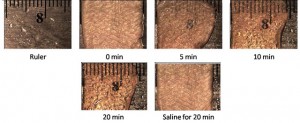Without the use of optical microscopy, routine study of subsurface biological processes with precise localization and quantitative accuracy currently is not feasible due to the high degree of optical scattering present in most biological tissues. A principal limitation of optical microscopy is that knowledge of dynamics at a systems level is extremely difficult to perform. Furthermore, since the field of view of microscopy is extremely small, determination of the appropriate spatial position to probe is a daunting task, especially in relatively large in vivo preparations.
In parallel with our WiFI instrument development research, we are investigating a chemical-based method, known as optical clearing, to engineer tissue optical properties. Specifically, the proposed research involves developing chemical formulations designed to reduce tissue optical scattering and hence improve our ability to visualize subsurface structures. The current issues under study are to identify chemical formulations that can penetrate intact skin and cause a transient reduction in tissue scattering in a safe and effective manner.
Collaborators: Eric Potma, UC Irvine; Alvin Yeh, Texas A&M University
